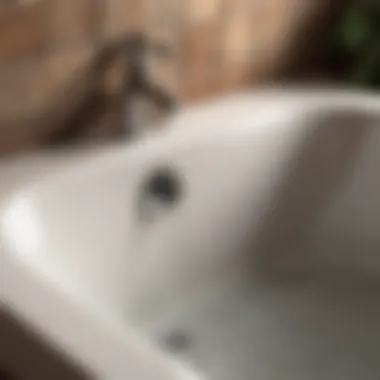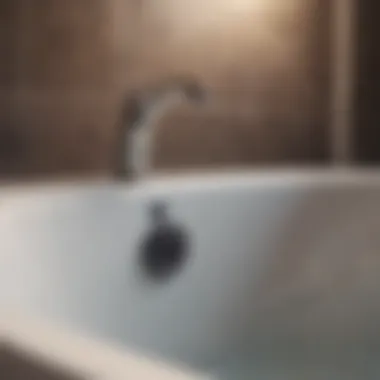Will Vinegar Unclog a Bathtub Drain Effectively?


Intro
Homeowners often look for simple and effective solutions for common household issues. One such issue is a clogged bathtub drain, which can disrupt daily routines. Many individuals wonder if household items, like vinegar, can provide a solution. This article analyzes the effectiveness of vinegar as a remedy for unclogging bathtub drains. By discussing vinegar’s scientific properties, examining common clog causes, and comparing this method to traditional plumbing solutions, we aim to deliver a thorough understanding of this topic.
Understanding Clogs
Before exploring the clearing methods, it’s important to understand why drains get clogged. Common culprits include:
- Hair,
- Soap scum,
- Hard water deposits,
- Foreign objects.
Knowing the root issues facilitates better solutions. Let’s consider how vinegar interacts with these plug sources.
The Science Behind Vinegar
Vinegar, primarily acetic acid, can break down grease and mineral buildups. This quality is why homeowners often turn to it as a natural cleaner. Two major components in vinegar help in unclogging drains:
- Acidity: The acetic acid reacts with alkaline substances, breaking them down.
- Dissolving Properties: Vinegar can help dissolve hair and soap residues that are obstructing flow.
However, it’s important to manage expectations. Vinegar may not work for every clog, especially those caused by solid objects or significant blockages.
Using Vinegar as a Drain Cleaner
If one decides to use vinegar for unclogging, here are practical steps:
- Gathering Supplies: You will need vinegar and, ideally, baking soda for added effectiveness.
- Pouring the Ingredients: Pour about one cup of baking soda followed by one cup of vinegar down the drain.
- Waiting Period: Let the mixture sit for at least 30 minutes. This allows the components to interact with the clog.
- Flushing with Hot Water: Finally, flush the drain with hot water to complete the process.
Limitations
Despite vinegar's benefits, there are limits. Strong, persistent clogs may not yield to this method. Persistent issues could require a more thorough approach, possibly involving a plumber.
Alternative Solutions
If vinegar fails, consider these alternatives:
- Hot Water: Simply pouring boiling water can loosen minor clogs.
- Plumbing Snake: This tool can reach deeper into pipes for another layer of unclogging.
- Chemical Drain Cleaners: Use these as a last resort, since they can damage pipes if overused.
End
Using vinegar as a remedy for clogged bathtub drains can be effective under the right circumstances. While it offers a safe, home-based solution, it is important to recognize when to escalate the issue to professional tools or help. Understanding both the benefits and limitations of vinegar allows homeowners to make informed decisions about drain maintenance. This knowledge is vital for not only keeping drains clear but also for maintaining a pleasant bathing environment.
Prolusion to Drain Clogs
Understanding the nature of drain clogs is essential for homeowners and those invested in maintaining their properties. A clogged drain can lead not only to inconvenience but also to more significant plumbing issues if not addressed promptly. In the context of bathtub drains, where water often accumulates during daily use, awareness of potential clogs can save homeowners from an unpleasant experience.
Understanding Drain Clogs
Drain clogs are typically caused by a build-up of materials in the pipes. Hair, soap residue, and other debris can contribute to this problem over time. As these substances accumulate, they can narrow the flow of water, leading to slow drainage or complete blockages. Understanding how these clogs form is the first step in preventing and addressing them effectively.
The materials in your tub can vary widely, and knowing what might be causing the blockage can inform how to address it. For example, long hair can easily coil around the drain mechanism, while soap scum can create a sticky film that traps further debris.
Common Signs of a Clogged Bathtub Drain


Recognizing the signs of a clogged bathtub drain early can prevent headaches later. There are several key indicators:
- Slow water drainage: The most common sign is water draining slowly, indicating that a clog may be forming.
- Unpleasant odors: Clogs can trap debris, leading to smells that escape through the drain.
- Gurgling noises: Unusual sounds when using other fixtures may suggest that air is trapped due to a blockage.
- Water pooling: If water starts to pool around your ankles while taking a shower, action is needed.
Identifying these signs early can help mitigate more severe issues down the line.
"Early detection of a clogged drain can save homeowners time and money in repairs and professional plumbing services."
By understanding what causes drain clogs and the signs that indicate a problem, individuals can take proactive measures. This awareness is crucial for effective treatment and maintenance of bathtub drains.
The Role of Vinegar in Cleaning
Vinegar is often heralded as a versatile cleaning agent in many households. Its appeal stems from its efficacy in addressing a spectrum of cleaning tasks, particularly in the context of clogged drains. Understanding vinegar’s potential can help homeowners make informed decisions when confronted with drainage issues. The inclusion of vinegar in the cleaning remedy toolkit hinges on its chemical properties, which allow it to interact with various substances found within drains.
Vinegar features acetic acid, primarily composed of water and acetic acid in varying concentrations. This component enables vinegar to dissolve mineral deposits, grease, and soap scum effectively. The slightly pungent odor is often an initial deterrent, yet its cleaning prowess cannot be overlooked. Many appreciate that vinegar serves as a natural alternative to harsher chemical products - a point that resonates with those concerned about environmental impact.
Additionally, vinegar’s non-toxic nature makes it appealing for households with children or pets. This highlights a practical advantage. Plus, using vinegar for DIY cleaning is cost-effective, typically less expensive than commercial cleaning solutions.
However, there are considerations. While vinegar can assist in minor clogs, it should not be relied upon for severe blockages or persistent plumbing issues. Indeed, its efficacy decreases in the face of certain materials commonly found in drains, such as hair and durable debris.
Ultimately, vinegar's role extends beyond mere cleaning; it captures the intersection of practicality, safety, and efficiency in home maintenance.
Chemical Composition of Vinegar
Vinegar's chief component is acetic acid, which generally constitutes about 5% of the liquid. The remaining content is mostly water. Depending on the type, vinegar can also contain other elements such as sugars and flavorings, but these are not significant for our focus on cleaning. The acetic acid in vinegar is what gives it its potent cleaning abilities. It works effectively by breaking down substances when combined with certain reactions, which can help dislodge debris within the drain.
When using vinegar as a cleaning solution, it’s crucial to note that its effectiveness can be influenced by its purity and concentration. Distilled white vinegar is often recommended for cleaning because it has a higher acetic acid concentration and fewer impurities. This variety not only minimizes unwanted odors but also maximizes effectiveness in breaking down grime.
How Vinegar Acts on Clogs
Vinegar acts on clogs through a combination of chemical reactions and physical properties. When poured down a drain, it engages with substances like soap scum, hair, and other organic materials that are typically the culprits behind clogs. The acetic acid begins to dissolve softer deposits while also creating effervescence when mixed with other substances, such as baking soda.
When vinegar encounters baking soda, for instance, it produces carbon dioxide gas. This bubbling action can aid in dislodging blockages by providing a physical force that pushes debris through pipes. This method is popular among DIY enthusiasts because it leverages simple household ingredients for effective results without resorting to more aggressive chemicals.
However, it’s important to note that vinegar might not be effective for all types of blockages. For instance, stubborn clogs made of solid objects will not respond well to vinegar. Its effectiveness is often limited to lighter materials typically found in bathroom drains.
In summary, understanding vinegar’s role in cleaning helps clarify its potential use in unclogging drains. Its chemical composition and interactive mechanisms provide a framework for evaluating its effectiveness against various plumbing challenges.
Vinegar as a DIY Solution
Vinegar has earned a solid reputation in households as a versatile cleaning agent. Its role in unclogging a bathtub drain represents a specific application of its broader cleaning properties. Embracing vinegar as a DIY solution is not only cost-effective but also an eco-friendly choice. Many homeowners aspire to manage minor plumbing issues independently, thus vinegar stands out as a popular remedy, providing a non-toxic alternative to traditional chemical drain cleaners.
Benefits of Using Vinegar
The benefits of using vinegar for unclogging bathtub drains are numerous. First, vinegar is readily available in most kitchens. This makes it an accessible option for immediate action when a clog appears. Additionally, vinegar is inexpensive. This provides a considerable advantage compared to commercial plumbing solutions, which often carry hefty price tags.
Furthermore, vinegar is safe for the environment. It does not emit harsh chemicals into the air or water systems, aligning with the growing preference for sustainable living practices. It can tackle various types of clogs, such as those formed by soap scum, hair, and grease, making it a multipurpose tool in home maintenance. Lastly, vinegar has antibacterial properties. While this may not directly clear a clog, it can help in maintaining a cleaner drain system overall.
Limitations of Vinegar for Drain Clogs
Despite its many benefits, relying solely on vinegar for resolving drain clogs has its limitations. Vinegar works primarily through acidic reactions, which may not be sufficient for severely clogged drains. For example, if there is a substantial blockage caused by foreign objects or significant buildup, vinegar might not provide the necessary force or potency to clear the way.


Another limitation is the time and effort involved. The process typically includes pouring vinegar and waiting for extended periods to see results. Many homeowners may not have the patience to allow vinegar to sit and work over time.
Additionally, the reaction between vinegar and baking soda, a common companion in DIY unclogging methods, can lead to fizzing that creates a temporary visual of a solution, but this reaction may not always translate into effective clog removal. In sum, while vinegar presents a practical option, it is vital to approach its use with realistic expectations regarding the extent of clogs it can effectively address.
Practical Techniques for Using Vinegar
The section on practical techniques for using vinegar is crucial in understanding how to apply this common household item effectively for unclogging bathtub drains. Knowing the steps to prepare the drain, the right proportions for mixing, and the timing required for optimum results can significantly enhance the chances of success. Vinegar, while being a natural option, needs to be treated with respect and precision to wield its cleaning power effectively.
Preparing the Drain for Vinegar Treatment
Before using vinegar to unclog a bathtub drain, it is essential to prepare the drain properly. Start by removing any visible debris or hair that could be contributing to the blockage. This can often be done by hand or with a specialized drain tool. Once the visible blockages are cleared, run hot water down the drain. This step helps to soften any residue that may be clinging to the pipes, making it easier for the vinegar to penetrate the clog.
Additionally, ensure that the drain is free from any leftover soap or oils. These substances can hinder the vinegar's action. If necessary, culled out soap scum with a gentle scrub brush.
Effective Proportions and Mixing Methods
When it comes to using vinegar for drain cleaning, the proportions are important for achieving the desired results. The most common recommendation is to use one cup of vinegar. The effective mixture would involve a combination of vinegar with baking soda for better outcomes. This involves pouring half a cup of baking soda into the drain first. After that, add a cup of vinegar and quickly cover the drain to contain the fizzing reaction that occurs. This reaction helps to break down the clog.
It's important to use a clean, preferably white vinegar for the task. Other types of vinegar may contain additional components that can complicate the cleaning process.
Timing and Waiting Period
Timing plays a significant role in the effectiveness of using vinegar to unclog a bathtub drain. After pouring the vinegar and baking soda mixture down the drain, allow it to sit for at least 30 to 60 minutes. This waiting period is vital as it gives the mixture enough time to work on loosening the debris within the pipes.
For tougher clogs, extending the waiting period may prove beneficial—some homeowners have found leaving the mixture overnight to provide better results. Following the wait, run hot water through the drain again. This final step can help flush away the loosened debris and residue, potentially restoring proper flow in the bathtub.
Using vinegar effectively requires attention to detail and the discipline to follow steps carefully. However, when done right, it can serve as a powerful ally in combatting bathtub drain clogs.
Comparing Alternatives to Vinegar
Identifying effective methods for unclogging a bathtub drain requires an understanding of the various approaches available, including vinegar's role in this process. While vinegar is often praised as a natural solution, it is essential to explore other alternatives that may perform better in specific contexts. The discussion of alternatives serves several purposes: assessing the efficacy of different methods, understanding the conditions under which each is most suitable, and providing homeowners with a broad toolkit for tackling plumbing issues.
Traditional Chemical Drain Cleaners
Traditional chemical drain cleaners offer a potent method for unclogging drains. These products typically contain aggressive ingredients such as sodium hydroxide or sulfuric acid. When introduced into a clogged drain, they can dissolve hair, grease, and other organic materials that may be contributing to the blockage.
Benefits of using chemical drain cleaners include:
- Speed: Many chemical cleaners work in a matter of minutes, providing rapid results.
- Effectiveness: They are often effective against tough clogs that vinegar may struggle to handle.
However, there are important considerations:
- Safety: Chemical cleaners can be hazardous if not used properly. They may produce toxic fumes or cause burns if they come into contact with skin. Proper protective equipment is necessary.
- Pipe Damage: Over time, these substances can corrode pipes, particularly in older plumbing systems. This long-term risk should not be overlooked.
Mechanical Methods: Plungers and Snake Tools
Mechanical methods, such as plungers and plumbing snakes, are often effective for physical obstructions in the drain. A plunger uses air pressure to dislodge clogs, while a plumbing snake, or auger, can reach further into the pipes to clear blockages.
The advantages of these methods include:
- Cost-Effectiveness: They typically require minimal investment and can be reused multiple times.
- Control: Homeowners can directly engage with the problem, rather than relying on chemicals.


However, these methods may require some experience to be effective. Improper use of a plunger can lead to splashing, while a plumbing snake can cause damage if mishandled. Homeowners should consider learning proper techniques before attempting these methods.
Professional Plumbing Services
When all else fails, professional plumbing services offer a reliable option for persistent drain issues. These experts come equipped with advanced tools and years of experience in diagnosing and solving plumbing problems.
Engaging a professional provides:
- Expert Diagnosis: They can identify underlying issues that may not be apparent to the average homeowner.
- Advanced Techniques: Professionals have access to tools such as hydro-jetting and camera inspections, which can thoroughly clean and assess the plumbing system.
While hiring a plumber can be more expensive than DIY methods, it is often the most effective when facing stubborn clogs or systemic issues. Furthermore, the peace of mind that comes with professional intervention can justify the cost.
"In choosing a solution for a clogged drain, weighing the pros and cons of each method is essential for effective and safe treatment."
Overall, exploring alternatives to vinegar not only broadens one’s knowledge base but ensures that homeowners are equipped to make informed decisions. Understanding various methods prepares you better for maintaining the functionality of your drainage system.
Long-term Maintenance of Bathtub Drains
Maintaining bathtub drains is essential not just for ease of use, but for preventing more serious issues in the plumbing system. Clogs can cause water to back up, leading to potential damage in both the bathtub and surrounding areas. In many cases, neglect can lead to higher repair costs, so proactive measures are key. A focus on long-term maintenance allows homeowners to enjoy a more functional, less troublesome bathtub.
Regular attention to the drain ensures that small issues do not develop into larger problems. Over time, accumulated hair, soap residue, and other debris can inhibit water flow. This not only hinders everyday use but fosters a breeding ground for bacteria and unpleasant odors.
Key elements to consider for long-term maintenance include:
- Understanding the anatomy of your drain: Knowing the parts involved and how they function can aid in identifying issues before they escalate.
- Routine inspections: Regularly check for any signs of slow drainage, which can indicate an imminent clog.
- Replacing worn parts: Over time, components of the drain can wear down. Addressing these replaces can prevent future clogs.
The benefits of effective long-term maintenance include a more enjoyable bathing experience, lower risk of major plumbing issues, and cost savings over time. Importantly, developing a consistent routine can greatly mitigate the need for drastic interventions, such as chemical cleaners or professional plumbing services.
Preventing Clogs: Best Practices
There are several best practices that can be implemented to help prevent clogs in bathtub drains. Adopting these simple yet effective methods can significantly reduce the likelihood of more serious plumbing issues. Some of them include:
- Using Drain Screens: Installing screens can capture hair and large debris, preventing them from entering the drain.
- Regularly Cleaning: A weekly cleaning of the drain area keeps soap scum and dirt from building up.
- Flushing with Hot Water: Pouring hot water down the drain can dissolve and flush away soap residue and oils that may contribute to clogs.
- Avoiding Excessive Use of Hair Products: Hair products often create build-up. Limiting usage or rinsing hair thoroughly can help.
Regular Cleaning Schedule Recommendations
A cleaning schedule is important for long-term drain health. Establishing a regular routine can make a significant difference in maintaining clear drains. Here are some recommendations:
- Weekly Maintenance: Conduct an inspection and clean the areas surrounding the drain, especially the overflow plate and surfaces.
- Monthly Deep Cleaning: Every month, use a safe cleaning solution to scrub the drain and surrounding pipes. Baking soda and vinegar can be effective for this purpose.
- Annual Professional Check-up: Have a plumber assess the drain system yearly. They can identify early signs of trouble that you might overlook.
Finale
Understanding the efficacy of vinegar in unclogging bathtub drains is crucial for homeowners looking to maintain or improve their home plumbing systems. By examining the scientific basis of how vinegar functions as a cleaning agent, as well as its pros and cons compared to other methods, this article has presented a well-rounded perspective on DIY plumbing solutions.
Summary of Findings
The findings indicate that vinegar can be a useful natural remedy for minor clogs. Its acetic acid content helps break down grease and soap scum, making it a practical option for regular maintenance. However, vinegar does have its limitations. For stubborn or severe clogs, methods such as chemical cleaners or professional plumbing services may be necessary. Here are some key points gleaned from the article:
- Vinegar's effectiveness is often best realized when used in conjunction with baking soda.
- Many common drain issues stem from hair, soap build-up, or foreign objects.
- While it is an eco-friendly alternative, vinegar might not wholly resolve every clog problem.
- Preventive measures are vital to minimize the need for extensive cleaning.
In addition to these points, it is clear that regular cleaning schedules can help mitigate the percentage of clog occurrences.
Final Thoughts on Vinegar Use
In summary, vinegar emerges as a viable option for those interested in practical, cost-effective solutions for bathtub clogs. Its appeal lies not only in its effectiveness against minor clogs but also in its environmentally friendly nature compared to traditional chemical cleaners. Despite these attributes, users should be realistic about their limitations.
Homeowners and enthusiasts alike may find value in balancing vinegar use with other techniques, especially in the case of severe blockages. Adoption of a combined approach can yield the best results. Furthermore, maintaining a regular cleaning regimen can ultimately preserve the functionality of your drains and prevent clogs from reoccurring.
In the end, all plumbing issues come with considerations and approaches that vary by circumstance. Being informed allows for proactive decisions in home maintenance.







